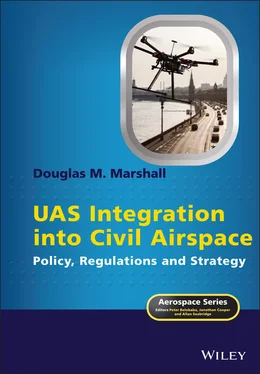Aside from the obvious concerns from those who do not trust technology to safely permit a large commercial aircraft to operate without a pilot on board, even over the oceans rather than populated terrain, Smith hit on one of the key elements that inhibits such operations from being approved by government regulators. The “holy grail” in the small UAS technology space is now national airspace (NAS) integration. Will society ever get to the point where autonomous systems will be allowed to operate in the same airspace as manned or piloted aircraft, or even be sufficiently comfortable with the safety mitigations to travel in an aircraft without a pilot on board? While the concept is no longer in the realm of futuristic representations of how things will be in 2050, as depicted in motion pictures and television productions, scaled-down versions of that vision are in the making now. Electrically powered aircraft are in the airworthiness approval stage with the FAA. Urban air mobility concepts under development by companies such as Airbus, Joby Aviation, Kitty Hawk, Lilium, Terrafugia, and Uber Air are well on their way to securing civil aviation authority approvals to market eVTOL (electric vertical takeoff and landing) prototypes that can operate at low altitudes in urban environments. “Self-flying” air taxis are already taking passengers on test flights in Chinese cities. Researchers, developers, regulators, and others are working very hard to create remotely piloted systems that can share airspace at lower airspace levels, in an environment that is unlikely to confront a remotely piloted B777 loaded to the rafters with computer chips and smart phones, and flying at 400 feet above ground at 250 kts. What is now possible is a remotely or autonomously piloted aircraft carrying emergency medical supplies to a person in need, dispatched from the nearest public safety facility and operating in your neighborhood at an altitude of less than 250 feet above ground level (AGL), possibly saving a life. Or delivering that FedEx package that may have been carried to a distribution center by a conventional aircraft, but replacing the ground vehicle currently needed to complete the last leg of the journey. While technologically possible now, these scenarios may only take place outside of strictly controlled test environments under the watchful eyes of regulatory agencies such as the US Federal Aviation Administration or its functional equivalents elsewhere, national civil aviation authorities.
There are many moving parts in the realm of unmanned aircraft systems. Capturing all of them and doing them justice would require several volumes. The one essential component of the UAS “big picture” is airspace management; thus the focus of this book. Even that subcategory calls for a recursive analysis, as any technology is made up of many components that themselves are technologies, which have subparts that are also technologies, and so on, in a repeating, or recurring fashion. The airspace management function is typically the exclusive province of civil aviation authorities focused on safety and the fundamental goal of keeping aircraft separated from one another so as to not create a hazard of a mid-air collision. This function has been largely successful for over 60 years, depending upon the country in question. Generally, the denser the airspace traffic, the greater the likelihood of a mishap. Midair collisions, though relatively rare when compared to the number of aircraft in flight at any one time in congested airspace, such as parts of the US and Europe, still happen, often with tragic results. In the list of the top 10 leading causes of fatal general aviation accidents in the US from 2001 to 2017, the last year this statistic is available, midair collisions ranked number eight. The number of near-midair collisions reported each year is approximately 200, and actual collisions average between 15 and 20. General aviation hours flown (those most important to our analysis because they are more likely to be found at low operating levels), totaled 25.9 million in the calendar year 2019.
The theme of this book focuses on just one of those many moving parts, the integration of unmanned aircraft into controlled and uncontrolled airspace. The ongoing regulatory and policy efforts around the world to achieve full airspace integration will be examined, which requires a functional breakdown of the key elements of the technology that must meet regulatory requirements before the systems will be permitted to go into full operation. Predictions of the future in this technology sector are fraught with uncertainty, but an attempt will be made to outline a probable path forward as revealed by government regulators and myriad interested parties. Among the other moving parts are ongoing regulatory developments for Operations Over People, operations Beyond Visual Line of Sight of the pilot in command, Remote Identification of aircraft, and Night Operations. While these components are critical features of the overall challenge of airspace integration, they will not be discussed in detail in this volume, except to the extent that it is necessary to clarify their role in the integration picture.
The rapid evolution of the technology underlying unmanned aircraft, unmanned aircraft systems, remotely piloted aircraft systems, and, more commonly, drones, among other terms of art, presents a formidable challenge to anyone attempting to encapsulate the entire domain in one book. The broad notion of unmanned or remotely piloted aircraft has been with us for over a century. Society has witnessed extraordinary developments in the field of unmanned aviation over the last 30 years or so. The categories or topics that now define or bound the current state of the art of this technology are too numerous to list here, but will be discussed in the body of this book.
The media and popular press adopted the catchall label “drone,” while experts and regulators generally prefer UAV, UAS, RPA, or RPAS instead of “drone,” because the term “drone” once had a very specific meaning. The early descriptions of these types of aircraft settled on “drone,” although the historical root of the term remains controversial (likened to a honeybee drone, or perhaps derived from a 1930s British target drone called a “Queen Bee”? No one really knows). In the earliest phases of development of unmanned aircraft, “drone” referred to target aircraft or remotely piloted offensive weapons deployed by both sides in both World Wars. Today’s unmanned aircraft are far more sophisticated, and in most cases more capable of non-military missions than the “true” drones of nine decades ago. This book will use drone, UAS, sUAS, UAV, UAS, and RPAS more or less interchangeably, as a matter of style and continuity, unless the specific term used calls for an explanation of why it is used in the context of the discussion.
Military organizations, primarily in the United States, led the way in developing drone technology from flying targets for aircraft weaponry and surface-based artillery to aerial sensor systems modified for intelligence, surveillance, and reconnaissance (ISR) missions. That capability soon led to development of platforms capable of carrying and deploying highly effective offensive munitions (such as the General Atomics’ Predator and Reaper series used in the first Gulf War and thereafter in subsequent Middle East conflicts).
Alongside the military’s tactical and strategic adoption of unmanned aerial systems, and the emerging market for civilian or scientific versions of those systems, the consumer sector emerged, which quickly realized the potential for unmanned systems in both the recreational and commercial arenas. Small (weighing less than 55 lb, or 2.2k), fixed-wing and rotorcraft contrivances were soon adapted for aerial photography, agriculture, building and infrastructure inspection, package delivery, entertainment, and any number of other applications having nothing to do with military operations. The sudden “Cambrian Explosion” of affordable and highly capable (consumer based) small UAS soon overwhelmed civil aviation authorities around the world with demands for access to low level airspace for a multitude of civilian uses.
Читать дальше












